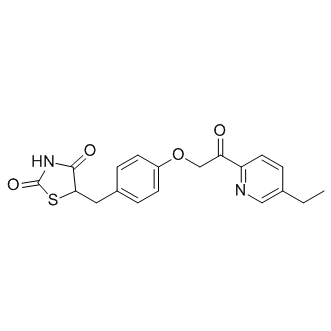
MSDC-0160
CAS No. 146062-49-9
MSDC-0160( PNU-91325 | Mitoglitazone )
Catalog No. M11984 CAS No. 146062-49-9
A new generation insulin sensitizer and mitochondrial target of thiazolidinediones (mTOT) modulator that has low affinity for binding and activation of PPARγ (EC50=23.7 uM).
Purity : >98% (HPLC)
 COA
COA
 Datasheet
Datasheet
 HNMR
HNMR
 HPLC
HPLC
 MSDS
MSDS
 Handing Instructions
Handing Instructions
| Size | Price / USD | Stock | Quantity |
| 2MG | 39 | In Stock |


|
| 5MG | 63 | In Stock |


|
| 10MG | 91 | In Stock |


|
| 25MG | 140 | In Stock |


|
| 50MG | 186 | In Stock |


|
| 100MG | 332 | In Stock |


|
| 200MG | Get Quote | In Stock |


|
| 500MG | Get Quote | In Stock |


|
| 1G | Get Quote | In Stock |


|
Biological Information
-
Product NameMSDC-0160
-
NoteResearch use only, not for human use.
-
Brief DescriptionA new generation insulin sensitizer and mitochondrial target of thiazolidinediones (mTOT) modulator that has low affinity for binding and activation of PPARγ (EC50=23.7 uM).
-
DescriptionA new generation insulin sensitizer and mitochondrial target of thiazolidinediones (mTOT) modulator that has low affinity for binding and activation of PPARγ (EC50=23.7 uM) and shows insulin-sensitizing effects in mouse models of diabetes; increases AMPK activity and reduces mTOR activity, maintains β-cell phenotype in human islets.Diabetes Phase 2 Clinical(In Vitro):MSDC 0160 (Mitoglitazone; 1-50 μM; for 24 hours) significantly decreases phosphorylation of mTOR at 20 and 50 μM.MSDC 0160 acts as insulin sensitizers without activating PPARγ.MSDC 0160 (10 μM; pretreatment 1 hour) prevents the MPP+ (10 μM)-induced loss of both tyrosine hydroxylase (TH)-immunoreactive differentiated Lund human mesencephalic (LUHMES) cells.MSDC 0160 (10 or 100 μM) prevents the loss of GFP-fluorescent dopaminergic neurons induced by MPP+ (0.75 mM) in nematodes.MSDC 0160 (10-20 μM) in conbination with IGF-1 prevents the loss of insulin content and maintains insulin secretion.MSDC 0160 (1-50 μM) treatment maintains human β-cell phenotype.(In Vivo):MSDC 0160 (Mitoglitazone; 30 mg/kg; oral gavage; daily; for 7 days) improves locomotor behavior, increases survival of nigral dopaminergic neurons, boosts striatal dopamine levels, and reduces neuroinflammation in 1-methyl-4-phenyl-1,2,3,6-tetrahydropyridine (MPTP)-treated mice.
-
In VitroWestern Blot Analysis Cell Line:Human islets.Concentration:1, 10, 20, 50 μM.Incubation Time:For 24 hours Result:Significantly decreased Phosphorylation of mTOR at 20 and 50 μM.
-
In VivoAnimal Model:Ten- to 12-week-old male C57BL/6J mice weighing 24 to 28 g Dosage:30 mg/kg Administration:Oral gavage; daily; for 7 days Result:Improved locomotor behavior, increased survival of nigral dopaminergic neurons, boosted striatal dopamine levels, and reduced neuroinflammation.
-
SynonymsPNU-91325 | Mitoglitazone
-
PathwayTyrosine Kinase
-
TargetInsulin Receptor
-
RecptormTOT
-
Research AreaMetabolic Disease
-
IndicationDiabetes
Chemical Information
-
CAS Number146062-49-9
-
Formula Weight370.4222
-
Molecular FormulaC19H18N2O4S
-
Purity>98% (HPLC)
-
SolubilityDMSO: ≥ 30 mg/mL
-
SMILESO=C(N1)SC(CC2=CC=C(OCC(C3=NC=C(CC)C=C3)=O)C=C2)C1=O
-
Chemical Name2,4-Thiazolidinedione, 5-[[4-[2-(5-ethyl-2-pyridinyl)-2-oxoethoxy]phenyl]methyl]-
Shipping & Storage Information
-
Storage(-20℃)
-
ShippingWith Ice Pack
-
Stability≥ 2 years
Reference



-
S961
S961 is an high-affinity and selective insulin receptor (IR) antagonist with IC50s of 0.048, 0.027, and 630 nM for HIR-A, HIR-B, and human insulin-like growth factor I receptor (HIGF-IR) in SPA-assay, respectively.
-
MSDC-0160
A new generation insulin sensitizer and mitochondrial target of thiazolidinediones (mTOT) modulator that has low affinity for binding and activation of PPARγ (EC50=23.7 uM).
-
Insulin degludec
Insulin degludec is an ultra-long-acting form of insulin used for the treatment of hyperglycemia caused by type 1 and type 2 dabetes. Insulin degludec shows binding efficiency with an IC50 value of 19.59 nM/L for insulin receptor. Insulin degludec can be used for the research of type 1 and type 2 diabetes.



 Cart
Cart
 sales@molnova.com
sales@molnova.com


